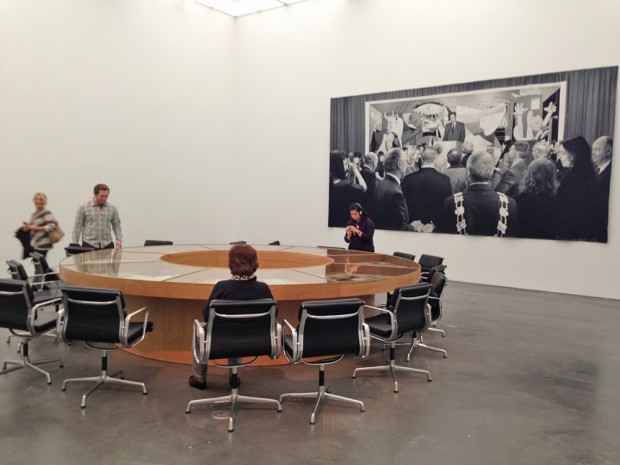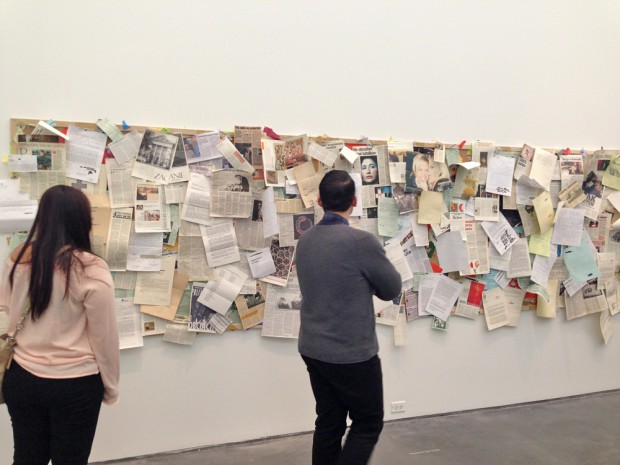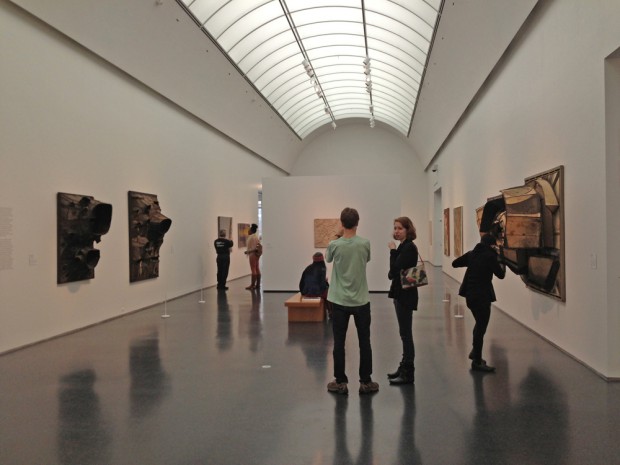
Goshka Macuga, "The Nature of the Beast", 2009, tapestry, wooden and glass table, leather and metal chairs, bronze sculpture on wooden plinth
The Museum of Contemporary Art Chicago has been on a roll recently. Rashid Johnson’s show “Message to Our Folks” was positively received this summer, as was their blockbuster “Skyscraper: Art and Architecture Against Gravity.” The MCA is still riding this wave of these successes with two massive exhibitions that are in many ways at opposite ends of the spectrum: the cool authoritarian aesthetic of Goshka Macuga’s “Exhibit, A” on one side, and the gritty, material anarchy of “Destroy the Picture: Painting the Void, 1949-1962” on the other.
Polish-born, London-based artist Goshka Macuga brings her brand of institutional critique to “Exhibit, A,” which opened December 15. The work requires more intellect than instinct to understand—something that was clear on the busy Sunday afternoon of my visit. The museum staff posted in the galleries were fielding questions and contributing their own thoughts. Young people with notebooks were huddling in pairs, gesturing at the walls. Others were taking cellphone pics of the wall texts and pouring over the vast assemblage of Polish language letters, headlines, leaflets and photographs pinned to Macuga’s “Notice Board”.
Macuga’s room-sized installations are heavily political, tackling war, nationalism, art history, gender discrimination and censorship. Soaring high above viewer’s heads is Macuga’s monumental, roughly-hewn plaster sculpture, “Model for a Sculpture (Family)”, referencing Argentinian artist Oscar Bony’s “La Familia Obrera (Workers’ Family)”; Bony’s work was censored by police in 1968, as they objected to the content inferred by the artist’s hiring of an actual working class family to enact his live sculpture. The forty-foot-long “Notice Board” seems to document, among other things, the Polish media’s reaction to and sensationalism of Maurizio Cattelan’s sculpture of the Pope John Paul II being hit by a meteorite, “La Nona Ora (The Ninth Hour)”.
Though the political stances in the artist’s work are often obvious, they’re fortunately more complex than mere exercises in finger-pointing. Macuga’s tapestry in “The Nature of the Beast” depicts Prince William addressing a crowd at Macuga’s 2009 exhibition at Whitechapel, which had borrowed one of Picasso’s anti-war Guernica tapestries—the one that usually hangs in the UN building in New York and was infamously covered up during Colin Powell’s address as he appealed in favor of the Iraq war. A boardroom-table-vitrine containing various photos, papers and propaganda sits in front of the tapestry, available to the public to be booked for meetings. The artist’s only requirement is that any such meetings must be documented, simultaneously establishing parameters for the audience to contribute to the work’s provenance, and acknowledging the lack of control an artist has over a work’s meaning over time.
While “Exhibit, A” is rather scholarly in its treatment of histories, “Destroy the Picture: Painting the Void,” is more visceral. This exhibition of abstraction between the years of 1949 and 1962 is an aesthetically cohesive survey that provides an alternative to the time period’s AbEx painting canon, and is also evidence that in this, Paul Schimmel’s final exhibition organized at MOCA, the curator is still crushing it. About a month after “Destroy the Picture” closed in LA, it opened in Chicago on February 16th with a press preview that included the reenactment of Saburo Murakami’s Entrance by the artist’s son, Tomohiko.
On the walls leading up to the exhibition is a large scale world map, each continent annotated with major events from the time period, reinforcing the global scope of this exhibition. Two of the first pieces a viewer encounters illustrating that fact are Shozo Shimamoto’s Sakuhin (Ana) from 1950 and Robert Rauschenberg’s untitled work from 1952 –two works from opposite sides of the world that look shockingly similar. Both are similarly sized monochromes (Shimamoto’s is white and Rauschenberg’s is black) and both make use of paint on newspaper, emphasizing this media’s susceptibility to inevitable destruction as time passes.
Though there are no paintings by the likes of Pollock, de Kooning and company, there’s no doubt that the emotive aggression embodied by that tradition (a reaction to the war and the violence that was witnessed all over the world) are also present here. The exhibition progresses in the magnitude of destruction, from the deskilling of Kazou Shiraga’s foot paintings and Lucio Fontana’s punctures through the canvas, to Alberto Burri’s burns, Yves Klein’s fire paintings and the shooting paintings of Niki de Sainte Phalle.
Some of the best surprises can be found as the exhibition shifts to collage and three-dimensionality. Chicagoans I spoke to were especially fond of four show-stealing works by Lee Bontecou, as they recalled the artist’s massive 2003 survey at the MCA that had reintroduced her after a decades-long absence from the art world. Lesser known British artist John Latham also makes a great showing with a massive multimedia work, “Great Uncle Estate” (1960) featuring dozens of books attached to the painting’s surface. French artists Raymond Hains and Jacques Villegle found abstractions in the world around them with works made of collaged, torn posters: a medium these two artists were mining while Mark Bradford was only a baby.




Comments on this entry are closed.